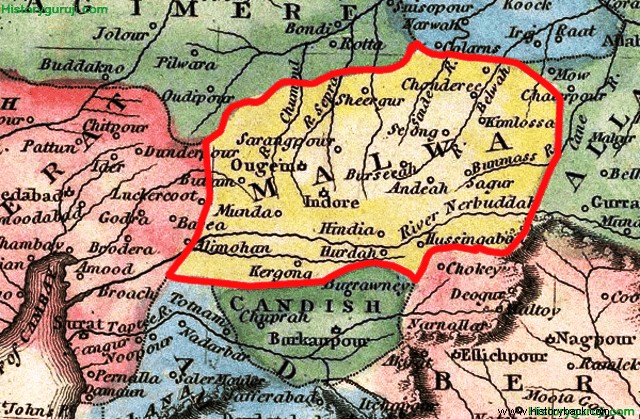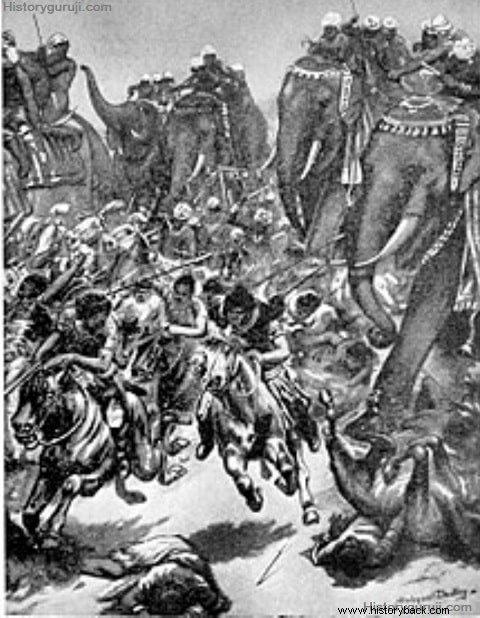Malwa was ruled by the Aulikar dynasty as feudatories of the Gupta Empire in the middle of the fifth century. At this time the power of the Guptas had weakened and Malwa was a victim of political instability due to the invasion of the Vakatakas and the Hunas. Records show that Adityavardhana had authority over western Malwa during the reign of Budhgupta. In fact, taking advantage of the political instability of Malwa after Kumaragupta II, Adityavardhana (490 AD) of the Aulikar dynasty declared his independence in western Malwa and established the Aulikar dynasty. Some historians also call this dynasty 'Aulikarvanshi Vardhan dynasty' on the basis of the name of Adityavardhana, the first independent ruler of this dynasty.

Prakashdharman (Bhagavatprakash), Vishnuvardhana That is, the names of Yashodharman and Dravyavardhan are found. Prakashdharman's Malav Samvat 572 (515 AD) has received a stone-plate inscription from a place called Rishtalpur near Mandsaur. It is clear from the date of the article that Prakashdharman was ruling in Malwa in AD 515-16. It is also known from this article that he had conquered eastern Malwa by defeating the Hun king Torman before 515 AD and assumed the title of 'Adhiraj'. But the most powerful of the Aulikar dynasty rulers was Yashodharman (Vishnavardhana). This powerful king of Malwa not only honored the Hun king Mihirkul, but also inflicted a deep blow on the Gupta Empire.
Achievements of Yashodharman (Vishnuvardhan)
Yashodharman (Vishnavardhana) rose like a meteor in the political skyline of central India and he soon dazzled the whole of northern India with the brilliance of his valor. The name of Yashodharman's father is found in the Risthalpur stone-panel inscription.
In relation to the achievements of Yashodharman of the Aulikarvanshi Vardhana dynasty, information is received from two inscriptions received from Mandsaur. The date of one in this is Malava Samvat 589 (532 AD). A brief account of his victories is given in this article. According to the article, 'After defeating many very powerful kings of the east and many kings of the north, he assumed the title of Rajadhiraj Parmeshwar. Under the control of his governor Abhayadatta, the region between the Vindhyas and the Pariyatra extended to the Arabian Sea.' This brief description is of the traditional Digvijaya.
Describing his conquests in the second inscription, it is said that his authority was also on those territories where the rule of Gupta kings could not be established and where the orders of the Huns were also Couldn't enter. He conquered the territories from the Lohitya (Brahmaputra) in the east to the sea in the west and from the Himalayas in the north to Mahendra Parvat (Ganjam district) in the south.
'Yeh Bhukta Guptanatharn Sakalvasudhakrant
Drishtaprataparnagyahunadhipanam Kshitipati MukutdhyasiniyanPravishta.
Alohityapakanthattalavangahanopatyakada
MahendradaGangaslishtasanostuhinshikharin paschimadapayyodhe.'
In connection with the conquest of this vast empire, there is no clear mention of the dynasties he defeated. Among the enemies defeated by him in the inscription, only Mihirkul's name is received in a poetic way.
Later Gupta Emperors and the End of the Gupta Dynasty
The Mandsaur Prashasti portrays Yashodharman as the Chakravarti king of North India. Although there is a degree of exaggeration in these praises, but such claims cannot be considered completely baseless. Yashodharman was a powerful ruler and the defeat of Mihirkul by him was one of his greatest achievements. It is clear from Hiuen Tsang's description and Mandsaur inscription that Mihirkul was defeated and overthrown from northern India by the Magadha king Baladitya and the ruler of Malwa, Yashodharman. Who defeated Mihirkul first is a matter of dispute. Some historians believe that King Yashodharman of Malwa and King Baladitya of Magadha had formed a union against the Huns in 528 AD and defeated Mihirkul together with the rest of the kings of India, but now this has been proved to be untrue.
The mighty ruler of Malwa, Yashodharman, defeated Mihirkul in the 6th century AD. In the Mandsaur inscription, Yashodharman boasts that 'the eminent king Mihirkul also brought a bounty at his feet'. Because of the Himalayas being proud of being inaccessible in vain, Yashodharman made him suffer by bending Mihirkul's head down with his muscle power and made him worship both his feet with the jute flowers of his hair. His style of doing, especially that 'his head had never bowed before anyone', bears no resemblance to the idea that he was defeated at the hands of Baladitya. From this, Hiuen Tsang's statement should be taken to be true that the ultimate destruction of Mihirkul's power was done by Baladitya and consequently the victory of Yashodharman was a precursor to that event. Father Heras also supports this view.
Rise and Fall of Hun Power in India
Harley's view is that Yashodharman as a feudal king sided with Narasimhagupta in the campaign against Mihirkul and then firmly declared his independent authority against his overlord. The tradition of victorious invasions was tied up and later his earlier successes against Mihirkul were considered as his independent victory.
The language of the Mandsaur text suggests that Mihirkul was only defeated, his kingdom and dominion were not destroyed. Some historians believe that Mihirkul lived for 10-15 years after that. Yashodharman must have defeated Mihirkul before 532 AD because the second Mandsaur inscription dated 532 AD shows that Yashodharman had defeated the north and north-east kings and assumed the title of 'Rajadhiraja Parameshwara'. Mihirkul must have been among the kings of these north. Mihirkula was defeated first by Yashodharman on behalf of the Gupta feudatory and then by Baladitya himself. According to Hiuen Tsang, after being defeated at the hands of Baladitya, Mihirkul established authority over Kashmir and Gandhara, but he died after a year.

Yashodharman the first Gupta emperor on behalf of the mighty Huns Defeated, then trampled the Gupta Empire by declaring his independence. Raychaudhary estimates that Yashodharman defeated and killed Baladitya's son Vajra and destroyed the Datta dynasty of Pundravardhan. But this is not confirmed by Hiuen Tsang's description. In the Mandsaur article, Yashodharman claimed to have conquered a region which was never owned by the Guptas or the Hunas. Probably it refers to the Vakataka dynasty because the Ajanta inscription shows that the Vakataka king Harishena had authority over Gujarat, Malwa, Kosala, Andhra, Kuntal etc. in 525 AD. Yashodharman seems to have captured Malwa after defeating him. In any case, Yashodharman's victories could not be permanent and his dominion had no effect. The copperplate-inscription received from North Bengal of 543 AD does not mention Yashodharman but mentions the Gupta emperor only. Apart from this, Parivrajak Maharaj, who ruled the Malwa region, accepted the suzerainty of the Gupta kings only. Thus, the period of rise of Yashodharman must have been between 528 to 543 AD. Probably his rule ended in 535 AD. The importance of Yashodharman is only that he encouraged other feudatories to become independent by his example, whose increasing power and the resulting struggle resulted in the disintegration of the Gupta Empire.
Yashodharman in Mandsaur Prashasti 'Janendra' Having said. Probably his full name Janendra Yashodharman was. Another name of him was Vishnuvardhana. He assumed the title of Rajadhirajparameshwara and emperor. He was a devotee of Shiva. There are many mentions of his good governance and virtues in the inscriptions. He has been compared to Manu, Bharata, Alarka and Mandhata.
Aulikarvanshi Dravyavardhana was probably a contemporary of Vishnugupta, the last ruler of the Gupta dynasty. Varahamihira's Brihatsamhita calls him 'avanti-nrup' has been addressed with the title of.
Post-Gupta Dynasty, Krishnagupta Dynasty
Maukhari Dynasty
